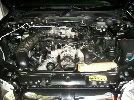With thanks to all those who offered guidance on this!
How to tell if your dash is real walnut veneer:
On the plastic dash the 'airbag' badge is literally an inlaid little badge. On the Walnut dash the word 'airbag' is in gold lettering and is beneath layers of clear lacquer.
Why you might want to do this:
Much stronger! Metal backed wood veneer is much more rigid than the plastic dash.
Much better fit.
Fabulous, lustrous, deep colour of the burr walnut. Note; it is a few shades darker than the plastic. A major improvement yet still looks ‘right’ with the other plastic panels…being lower down they get less light and hence remain a good match!
Special tools:
Flat metal implement.
Stanley knife.
Hollow centred Star Driver size T20
Normal Star driver piece T10
15 M3 size machine screws – you may need to saw these to the correct length. (If so, screw on a nut before sawing in case you need to re-cut the thread.
Popping the dash panels:
Using a flat edged implement you can pop out the dash panels at the bottom. Exercise care with regards to the metal clips that hold the panels in place, whilst springy they are also quite brittle and therefore prone to breaking.
Passenger’s side: err to the RH edge, be aware that you will need to gently move this piece to the right and up in order to release the air funnel.
Airbag: you will need to lever about an inch in from either side of the bottom edge, note that this will remain attached to the dash by the safety strap for the time being. Obviously ensure the car is switched off before doing this one!
Instrument surround: start on the LH side, then just to the left of the instrument cluster and finally the bottom far left. Be careful with this piece as it has the clock wires and the fresh air control cable attached to it.
Removing the air vents from the dash surround and re-fitting in the wood dash:
You will require a hollow centred ‘Star Driver’ set for the airbag part of this. The self tapping screws holding the vents to the dash require a normal T10 size Star driver and the airbag a hollow centred T20.
Passenger side: remove the three screws securing the vent to the dash panel, whilst taking note of which way up the metal clips should be! You will find that the vent and plastic retaining clip do not sit so snugly when transferred to the wood dash panel. Solve this by slicing off about 1mm of plastic with a Stanley knife from the bottom edges of the sections that fit over the screw threads. Take care not to take off too much or the vent will sit unevenly in the dash panel. Then use the M3 machine screws to attach the vent to the dash panel – the self tappers from the plastic dash will NOT fit. Refit this panel first ensuring the black plastic clip sits under the top edge of the bulkhead panel. You may find the moulded stay on the RH side requires widening slightly with a Stanley knife in order to get a snug fit.
Airbag: carefully remove the 7 screws using the hollow centred Star driver T20. Do not lose these as they WILL fit the replacement airbag dash cover. Make sure you keep the safety strap in position when attaching the new dash panel. This panel is the easiest to pop back on correctly. Pop this one back in second.
Instrument surround: It is just possible to do this job without untethering the fresh air control cable but take great care when removing the various vents etc so as not to scratch anything! I took the vents out first, which gave more room for unscrewing the fresh air wheel. Make a note of where the various clips and screws are located in this panel as there are quite a lot of them! All parts are a straight swap over with the exception of the self tapping screws (use the machine screws) and the metal retaining clips. You can remove these and re-use them but you stand a good chance of messing up the plastic stubs they are attached to. New replacements are a better bet if you want to sell on the old dash. Replacement of this dash section should be last. Top edge first, ensuring the black plastic locating spigot goes behind the bulkhead. Pop in the lower half, starting on the LH side.
And there you have it, a dash worth polishing!
Disclaimer:
You are responsible for any work or modifications carried out on your car and you undertake any such work at your own risk. The 75ZT Community nor the original author of this How-To can be held liable for anything that may happen as a result of you following this How-To.





